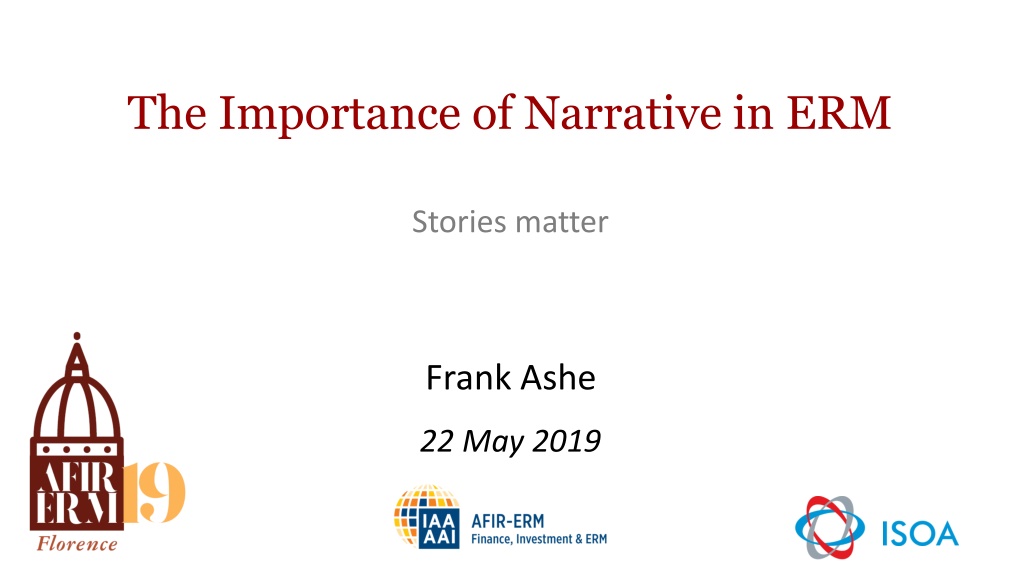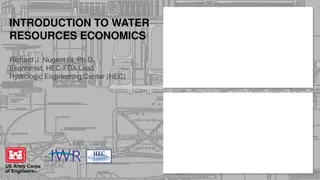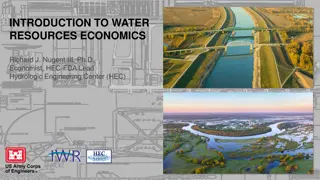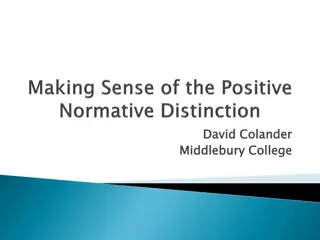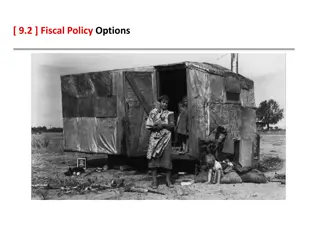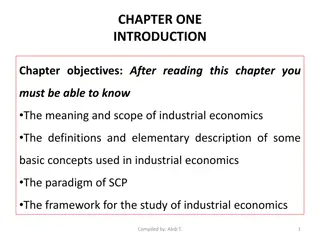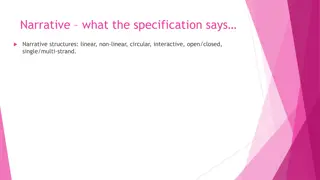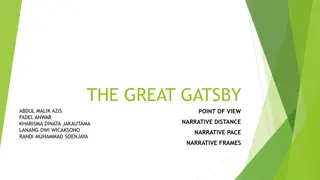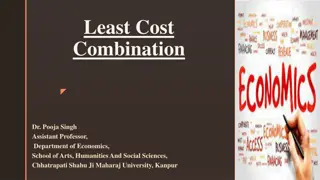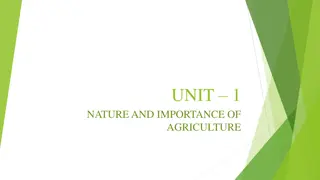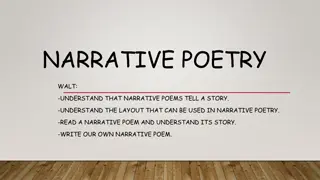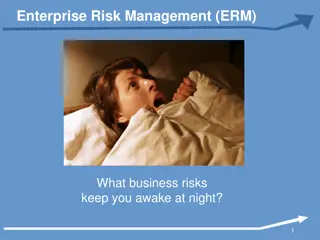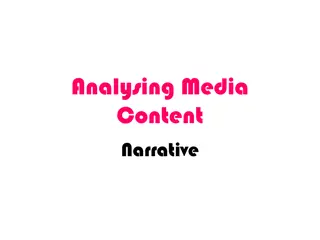The Power of Narrative in ERM and Economics
Narrative plays a crucial role in risk management, as it helps in better understanding and decision-making. The use of stories in risk dashboards and economic narratives can convey complex information effectively. Robert Shiller's concept of narrative economics explores how popular stories impact economic fluctuations. By presenting information in a narrative form, the message becomes more engaging and influential.
Download Presentation

Please find below an Image/Link to download the presentation.
The content on the website is provided AS IS for your information and personal use only. It may not be sold, licensed, or shared on other websites without obtaining consent from the author.If you encounter any issues during the download, it is possible that the publisher has removed the file from their server.
You are allowed to download the files provided on this website for personal or commercial use, subject to the condition that they are used lawfully. All files are the property of their respective owners.
The content on the website is provided AS IS for your information and personal use only. It may not be sold, licensed, or shared on other websites without obtaining consent from the author.
E N D
Presentation Transcript
The Importance of Narrative in ERM Stories matter Frank Ashe 22 May 2019
Introduction Introduction We love stories, I m spinning a yarn now. In contrast, rational thinking is hard. Our brain is disposed to listen to stories and to generate them. It s much easier to absorb information via a narrative stream that puts in the pegs on which to hang information at the same time as it presents the information. 2
Introduction Introduction From the point of view of risk management, the dangers are that we don t understand the information presented because of cognitive overload, or we realise the inconsistency of two stories concerning our company when it is too late. A strong component of risk management is the dissemination of the pertinent information to the appropriate people. If the risk analysis can be presented as a more easily understood story, then it should elicit better responses from the recipients 3
Risk Dashboards? Risk Dashboards? Examples from Google search on risk management dashboards
Each of these dashboards needs a story Each of these dashboards needs a story Anybody trying to understand these dashboards has to turn them into a story, done either Internally, or Presenter, or Accompanying prose Doing it internally presents danger of misinterpretation Accompanying prose takes time, usually only for condensation to senior executives and Boards.
Economics Economics Robert Shiller raised the issue in the sphere of economics. By narrative economics I mean the study of the spread and dynamics of popular narratives, the stories, particularly those of human interest and emotion, and how these change through time, to understand economic fluctuations. I use the term narrative to mean a simple story or easily expressed explanation of events that many people want to bring up in conversation or on news or social media because it can be used to stimulate the concerns or emotions of others, and/or because it appears to advance self- interest. To be stimulating, it usually has some human interest either direct or implied. As I (and many others) use the term, a narrative is a gem for conversation, and may take the form of an extraordinary or heroic tale or even a joke. It is not generally a researched story, and may have glaring holes, as in urban legends. (Shiller Narrative Economics 2017)
Ngram Ngramof the 3 main risks in finance of the 3 main risks in finance
Ngram NgramERM ERM
Narrative is becoming more commonly discussed Narrative is becoming more commonly discussed
Narrative and business Narrative and business
Narrative psychology Narrative psychology As I see it, the concept of narrative should focus on how narrative works to create meanings. I take this to be the principal mission of narrative, basic to what makes it such an attractive concept. Narrative allows researchers insight into the process of meaning making. (Schiff The Function of Narrative: Toward a Narrative Psychology of Meaning 2012) Narrative psychology is the view that human nature is fundamentally tied to stories.
Narrative psychology has taken off Narrative psychology has taken off The importance of narrative within the psychology of a person has achieved more importance.
Narrative and evolution Narrative and evolution The prefrontal cortex (pFC), the newest part of the brain in an evolutionary sense, is sometimes called the "executive" region, because it draws inputs from almost all other regions, integrates them to form near and long-term goals, and plans actions that take these goals into account. Part of its processing for this is to spin a story about the world. Here s a quote from Gazzaniga[1], one of the long-term investigators in this area.
Narrative and Evolution (ii) Narrative and Evolution (ii) Gazzaniga (1989, 1995) and Metcalfe et al. (1995) have hypothesized the existence of an interpreter that plays the role oftrying to make sense out of the information that it confronts,in other words, generating causal hypotheses. Using split-brainpatients, Gazzaniga (1995) provided evidence that this interpreteris located in the left hemisphere in most individuals. The simultaneousconcept test provides an example of the function of the interpreter.In this task, a split-brain patient is shown a picture exclusivelyto the left hemisphere (e.g., a chicken) and another picture exclusivelyto the right hemisphere (e.g., a snow scene). The patient is thengiven an array of pictures and asked to point to a picture associatedwith the presented pictures. In the above example, the left hemispherechose a chicken claw, and the right hemisphere chose a shovel.When asked to explain the choices, the patient responded, "Oh,that's simple. The chicken claw goes with the chicken, and youneed a shovel to clean out the chicken shed." The right hemisphereis unable to produce speech, so it cannot explain its selection.The left hemisphere is unaware of the picture that the right hemisphereis responding to (i.e., the snow scene), so it must generate itsown interpretation of why the left hand pointed to a shovel. Theleft hemisphere, observing the actions of the left hand and rightbrain, interprets those actions within the context of what itknows (i.e., a chicken claw) and generates an explanation forthe shovel that is consistent with its knowledge (Gazzaniga, 1989).
Presenting information Presenting information Presenting information in a narrative structure significantly enhances its ability to be remembered. Narrative processing is a universal human trait[2] and the forms that it takes are also universal. Gazzaniga s interpreter that tries to make sense out of the information it confronts is spinning a tale about the world this happened because of that, and then he did this, and she did that, and so on and so on.
Presenting information (ii) Presenting information (ii) And because people are such an important part of the environment for a social species such as ourselves, many of the interpretations of the world come attached with hypotheses concerning the mental state of the actors why did she do this, why didn t he stop that happening?[3] Two very strong messages come out of this for the risk management realm: if information is presented in a coherent narrative then it will be much more easily believed; we have a tendency to anthropomorphise too readily.
Dissonance Dissonance The risk management realm is far from certain. If somebody can tell a simple story, for example what are macro trends, and this accords with some of the information we have seen, then the story is believable. Another person can come along and tell a story about different macro trends, and this can rely on some observations we have made ourselves as well, the story is believable.
Dissonance (ii) Dissonance (ii) It sometimes takes cognitive effort to realise that the two stories are contradictory. When we realise the contradiction, we feel sick. What happens if we don t realise the stories are contradictory Don t think this won t happen to you! If you think this then you are in great danger of falling for other cognitive biases!
Contradictory information Contradictory information Research by Drew Westen at Emory University[4] uses fMRI to see what happens when we come across information that does not accord with a pre-existing story we ve believed. The US study took ardent Democrats and Republicans in the 2004 presidential elections and, while in the machine, presented them with TV clips of both candidate saying something contradictory, a common event on the campaign trail under the pressure of electioneering. The opposing party was recognised as being contradictory, but both Democrats and Republicans interpreted their candidate in a favourable light.
Contradictory information (ii) Contradictory information (ii) When assessing the favoured candidate the rational part of the brain was not engaged. The parts of the brain associated with the processing of emotions, conflict resolution, and making judgements about moral accountability were all active, and this is associated with a feeling of discomfort. When a conclusion had been reached with which the subject was comfortable, the ventral striatum kicked in the region of the brain associated with reward and pleasure. As Westen said Essentially, it appears as if partisans twirl the cognitive kaleidoscope until they get the conclusions they want, and then they get massively reinforced for it, with the elimination of negative emotional states and activation of positive ones.
Contradictory information (iii) Contradictory information (iii) The reinforcement comes from mentally resolving the contradiction, not necessarily correctly. Our default mechanism is to reinterpret the information until it fits our preconception we resolve the cognitive dissonance. This is not a good thing! Get the information into a narrative to mitigate the effect of the preconceptions.
Contradictory information (iv) Contradictory information (iv) Complementing this result is research by Fugelsang et al[5] that shows that the neurological pathways involved in the first level of processing of information depends on whether the information being presented is consistent or inconsistent with our prior beliefs. Inconsistent information follows the pathway outlined in the previous paragraph. Consistent information lights up brain regions associated with memory and learning. Note that there is no default control over which process is in place. There is automatic streaming taking place before conscious thought has a chance to kick in.
Contradictory information (v) Contradictory information (v) As Fugelsang et al[6], and Heuer[7]note, there are procedures available which help to reduce this innate bias presentation of disconfirming information, reminding people that bias is possible - and many of these techniques are already used in business. What this research shows us is how pervasive is the biasing process. Our balancing mechanisms need to be potentially active at all decision levels to ensure optimum performance with adjustment for the cognitive and real costs of the checks and balances. Making a narrative is an additional method, and can include these ideas.
Footnotes Footnotes Wolford, Miller and Gazzaniga - The Left Hemisphere's Role in Hypothesis Formation (2000) Sugiyama - Narrative Theory and Function: Why Evolution Matters (2001) For an introductory analysis of the implications of all this psychology on most people s usual view of communication, which is usually a na ve blend of Locke s original 1690 view and Shannon s 1949 mathematical view of communication, see Radford - On the Philosophy of Communication (2005) Needless to say, things get more complicated than simply Who, Says What, Through which Channel, to Whom, with What Effect. [4] Discussed in Shermer - The Political Brain (2006) [5] Fugelsang and Dunbar - A cognitive neuroscience framework for understanding causal reasoning and the law (2004) [6] ibid. [7] Heuer Jr. - Psychology of Intelligence Analysis (1999) [1] [2] [3]
What to do? What to do? Narrative is also involved in systemic risk, where bubbles and their bursting are linked to narratives, and a loss of trust in a marketplace can be spread by a superficially plausible, but incorrect, narrative. Further, the ESG framework has spread because of a surrounding narrative that fits a social trend in other areas of the economy. A CRO needs to understand the importance of narrative in areas such as corporate culture - especially risk culture strategic risk, governance, and communication.
What to do? What to do? This talk is too short to cover the issue Narrative is what allows us to understand lots of complex information Look at The Odyssey to see how complex information can be told in a complex fashion yet still be eminently understandable and enjoyable and that was 3,000 years ago Risk management does not use enough narrative in its most important job communication Turn your dashboards into stories The bigger the risk, the more a story is needed corporate strategy is the biggest risk, so needs the best story
